First-Principles Forecast of Gapless Half-Metallic and Spin-Gapless Semiconducting Materials: Case Study of Inverse Ti2CoSi-Based Compounds
Abstract
Featured Application
Abstract
1. Introduction
2. Materials and Methods
2.1. Structure of Materials
2.2. Computational Methods
3. Results and Discussion
3.1. Crystal Structures and Lattice Parameters
3.2. Electronic Structures and Magnetic Properties
4. Conclusions
Author Contributions
Funding
Conflicts of Interest
References
- Brown, P.J.; Neumann, K.U.; Webster, P.J.; Ziebeck, K.R.A. The magnetization distributions in some Heusler alloys proposed as half-metallic ferromagnets. J. Phys. Condens. Matter 2000, 12, 1827. [Google Scholar] [CrossRef]
- Žutić, I.; Fabian, J.; Sarma, S.D. Spintronics: Fundamentals and applications. Rev. Mod. Phys. 2004, 76, 323. [Google Scholar] [CrossRef]
- Berri, S. First-Principles Calculations to Investigate the Structural, electronic, and half-metallic properties of Ti2RhSn1-xSix, Ti2RhSn1-xGex, and Ti2RhGe1-xSix (x = 0, 0.25, 0.5, 0.75, and 1) quaternary Heusler alloys. J. Supercond. Nov. Magn. 2019, 32, 2219–2228. [Google Scholar] [CrossRef]
- Alijani, V.; Winterlik, J.; Fecher, G.H.; Naghavi, S.S.; Felser, C. Quaternary half-metallic Heusler ferromagnets for spintronics applications. Phys. Rev. 2011, 83, 184428. [Google Scholar] [CrossRef]
- Gao, G.Y.; Hu, L.; Yao, K.L.; Luo, B.; Liu, N. Large half-metallic gaps in the quaternary Heusler alloys CoFeCrZ (Z = Al, Si, Ga, Ge): A first-principles study. J. Alloy Compd. 2013, 551, 539–543. [Google Scholar] [CrossRef]
- Singh, M.; Saini, H.S.; Thakur, J.; Reshak, A.H.; Kashyap, M.K. Electronic structure, magnetism and robust half-metallicity of new quaternary Heusler alloy FeCrMnSb. J. Alloy Compd. 2013, 580, 201–204. [Google Scholar] [CrossRef]
- Özdoğan, K.; Şaşıoğlu, E.; Galanakis, I. Slater-Pauling behavior in LiMgPdSn-type multifunctional quaternary Heusler materials: Half-metallicity, spin-gapless and magnetic semiconductors. J. Appl. Phys. 2013, 113, 193903. [Google Scholar] [CrossRef]
- Zhang, Y.J.; Liu, Z.H.; Li, G.T.; Ma, X.Q.; Liu, G.D. Magnetism, band gap and stability of half-metallic property for the quaternary Heusler alloys CoFeTiZ (Z = Si, Ge, Sn). J. Alloy Compd. 2014, 616, 449–453. [Google Scholar] [CrossRef]
- Xiong, L.; Yi, L.; Gao, G.Y. Search for half-metallic magnets with large half-metallic gaps in the quaternary Heusler alloys CoFeTiZ and CoFeVZ (Z = Al, Ga, Si, Ge, As, Sb). J. Magn. Magn. Mater. 2014, 360, 98–103. [Google Scholar] [CrossRef]
- Al-zyadi, J.M.K.; Gao, G.Y.; Yao, K.L. Theoretical investigation of the electronic structures and magnetic properties of the bulk and surface (001) of the quaternary Heusler alloy NiCoMnGa. J. Magn. Magn. Mater. 2015, 378, 1–6. [Google Scholar] [CrossRef]
- Felser, C.; Wollmann, L.; Chadov, S.; Fecher, G.H.; Parkin, S.S. Basics and prospective of magnetic Heusler compounds. APL Mater. 2015, 3, 041518. [Google Scholar] [CrossRef]
- Kundu, A.; Ghosh, S.; Banerjee, R.; Ghosh, S.; Sanyal, B. New quaternary half-metallic ferromagnets with large Curie temperatures. Sci. Rep. 2017, 7, 1803. [Google Scholar] [CrossRef] [PubMed]
- Wang, X.L. Proposal for a new class of materials: Spin gapless semiconductors. Phys. Rev. Lett. 2008, 100, 156404. [Google Scholar] [CrossRef] [PubMed]
- Ouardi, S.; Fecher, G.H.; Felser, C.; Kubler, J. Realization of spin gapless semiconductors: The Heusler compound Mn2CoAl. Phys. Rev. Lett. 2013, 110, 100401. [Google Scholar] [CrossRef]
- Heusler, F. Über magnetische manganlegierungen. Verh. Dtsch. Phys. Ges. 1903, 5, 219. [Google Scholar]
- Jiang, D.G.; Ye, Y.X.; Yao, W.B.; Zeng, D.W.; Zhou, J.; Liu, L.N.; Wen, Y.F. First-principles calculations of the structural, magnetic, and electronic properties of Fe2MgB full-Heusler alloy. J. Electron. Mater. 2019, 48, 7258–7262. [Google Scholar] [CrossRef]
- Moodera, J.S.; Nassar, J.; Mathon, G. Spin-tunneling in ferromagnetic junctions. Annu. Rev. Mater. 1999, 29, 381. [Google Scholar] [CrossRef]
- Skaftouros, S.; Ozdogan, K.; Sasioglu, E.; Galanakis, I. Search for spin gapless semiconductors: The case of inverse Heusler compounds. Appl. Phys. Lett. 2013, 102, 022402. [Google Scholar] [CrossRef]
- Xu, G.Z.; Liu, E.K.; Du, Y.; Li, G.J.; Liu, G.D.; Wang, W.H.; Wu, G.H. A new spin gapless semiconductors family: Quaternary Heusler compounds. Europhys. Lett. 2013, 102, 17007. [Google Scholar] [CrossRef]
- Kudryavtsev, Y.V.; Oksenenko, V.A.; Lee, Y.P.; Hyun, Y.H.; Kim, J.B.; Park, J.S.; Park, S.Y.; Dubowik, J. Evolution of the magnetic properties of Co2MnGa Heusler alloy films: From amorphous to ordered films. Phys. Rev. B 2007, 76, 024430. [Google Scholar] [CrossRef]
- Jamer, M.E.; Assaf, B.A.; Devakul, T.; Heiman, D. Magnetic and transport properties of Mn2CoAl oriented films. Appl. Phys. Lett. 2013, 103, 142403. [Google Scholar] [CrossRef]
- Xu, G.Z.; Du, Y.; Zhang, X.M.; Zhang, H.G.; Liu, E.K.; Wang, W.H.; Wu, G.H. Magneto-transport properties of oriented Mn2CoAl films sputtered on thermally oxidized Si substrates. Appl. Phys. Lett. 2014, 104, 242408. [Google Scholar] [CrossRef]
- Feng, W.W.; Fu, X.; Wan, C.H.; Yuan, Z.H.; Han, X.F.; Quang, N.V.; Cho, S. Spin gapless semiconductor like Ti2MnAl film as a new candidate for spintronics application. Phys. Status Solidi RRL 2015, 9, 641. [Google Scholar] [CrossRef]
- Lukashev, P.; Kharel, P.; Gilbert, S.; Staten, B.; Hurley, N.; Fuglsby, R.; Huh, Y.; Valloppilly, S.; Zhang, W.; Yang, K.; et al. Investigation of spin-gapless semiconductivity and half-metallicity in Ti2MnAl-based compounds. Appl. Phys. Lett. 2016, 108, 141901. [Google Scholar] [CrossRef]
- Dulal, R.P.; Dahal, B.R.; Forbes, A.; Bhattarai, N.; Pegg, I.L.; Philip, J. Weak localization and small anomalous Hall conductivity in ferromagnetic Weyl semimetal Co2TiGe. Sci. Rep. 2019, 9, 3342. [Google Scholar] [CrossRef] [PubMed]
- Dahal, B.; Huber, C.; Zhang, W.; Valloppilly, S.; Huh, Y.; Kharel, P.; Sellmyer, D. Effect of partial substitution of In with Mn on the structural, magnetic, and magnetocaloric properties of Ni2Mn1+xIn1−x Heusler alloys. J. Phys. D Appl. Phys. 2019, 52, 425305. [Google Scholar] [CrossRef]
- Casper, F.; Graf, T.; Chadov, S.; Balke, B.; Felser, C. Half-Heusler compounds: Novel materials for energy and spintronic applications. Semicond. Sci. Technol. 2012, 27, 063001. [Google Scholar] [CrossRef]
- Graf, T.; Felser, C.; Parkin, S.S.P. Simple rules for the understanding of Heusler compounds. Prog. Solid State Chem. 2011, 39, 1–50. [Google Scholar] [CrossRef]
- Kandpal, H.C.; Fecher, G.H.; Felser, C. Calculated electronic and magnetic properties of the half-metallic, transition metal based Heusler compounds. J. Phys. D Appl. Phys. 2007, 40, 1507. [Google Scholar] [CrossRef]
- Bradley, A.J.; Rodgers, J.W. The crystal structure of the Heusler alloys. Proc. R. Soc. Lond. Ser. A 1934, 144, 340. [Google Scholar] [CrossRef]
- Payne, M.C.; Teter, M.P.; Allan, D.C.; Arias, T.A.; Joannopoolous, J.D. Iterative minimization techniques for ab initio total-energy calculations: Molecular dynamics and conjugate gradients. Rev. Mod. Phys. 1992, 64, 1065. [Google Scholar] [CrossRef]
- Vanderbilt, D. Soft self-consistent pseudopotentials in a generalized eigenvalue formalism. Phys. Rev. B 1990, 41, 7892. [Google Scholar] [CrossRef] [PubMed]
- Milman, V.; Winkler, B.; White, J.A.; Pickard, C.J.; Payne, M.C.; Akhmatskaya, E.V.; Nobes, R.H. Electronic structure, properties, and phase stability of inorganic crystals: A pseudopotential plane-wave study. Int. J. Quantum Chem. 2000, 77, 895. [Google Scholar] [CrossRef]
- Segall, M.D.; Lindan, P.J.D.; Probert, M.J.; Pickard, C.J.; Hasnip, P.J.; Clark, S.J.; Payne, M.C. First-principles simulation: Ideas, illustrations and the CASTEP code. J. Phys. Condens. Matter 2002, 14, 2717. [Google Scholar] [CrossRef]
- Clark, S.J.; Segall, M.D.; Pickard, C.J.; Hasnip, P.J.; Probert, M.I.J.; Refson, K.; Payne, M.C. First principles methods using CASTEP. Z. Krist. Cryst. Mater. 2005, 220, 567–570. [Google Scholar] [CrossRef]
- Hasnip, P.J.; Refson, K.; Probert, M.I.J.; Yates, J.R.; Clark, S.J.; Pickard, C.J. Density functional theory in the solid state. Philos. Trans. R. Soc. A 2014, 372, 20130270. [Google Scholar] [CrossRef]
- Perdew, J.P.; Chevary, J.A.; Vosko, S.H.; Jackson, A.; Pederson, M.R.; Fiolhais, C. Atoms, molecules, solids, and surfaces: Applications of the generalized gradient approximation for exchange and correlation. Phys. Rev. B 1992, 46, 6671. [Google Scholar] [CrossRef] [PubMed]
- Perdew, J.P.; Burke, K.; Ernzerhof, M. Generalized gradient approximation made simple. Phys. Rev. Lett. 1996, 77, 3865. [Google Scholar] [CrossRef] [PubMed]
- Waybright, J.; Halbritter, L.; Dahal, B.; Qian, H.; Huh, Y.; Lukashev, P.; Kharel, P. Structure and magnetism of NiFeMnGaxSn1-x (x = 0, 0.25, 0.5, 0.75, 1.00) Heusler compounds. AIP Adv. 2019, 9, 035105. [Google Scholar] [CrossRef]
- Wu, B.; Huang, H.; Zhou, G.; Feng, Y.; Chen, Y.; Wang, X. Structure, magnetism, and electronic properties of inverse Heusler alloy Ti2CoAl/MgO(100) herterojuction: The role of interfaces. Appl. Sci. 2018, 8, 2336. [Google Scholar] [CrossRef]
- Wu, B.; Huang, H.; Li, P.; Zhou, T.; Zhou, G.; Feng, Y.; Chen, Y. First-principles study on the structure, magnetism, and electronic properties in inverse Heusler alloy Ti2FeAl/GaAs(100) heterojunction. Superlatt. Microstruct. 2019, 133, 106205. [Google Scholar] [CrossRef]
- Fujii, S.; Ishida, S.; Asano, S. A half-metallic band structure and Fe2MnZ (Z = Al, Si, P). J. Phys. Soc. Jpn. 1995, 64, 185–191. [Google Scholar] [CrossRef]
- Ishida, S.; Fujii, S.; Kashiwagi, S.; Asano, S. Search for half-metallic compounds in Co2MnZ (Z = IIIb, IVb, Vb element). J. Phys. Soc. Jpn. 1995, 64, 2152–2157. [Google Scholar] [CrossRef]
- Miura, Y.; Shirai, M.; Nagao, K. Ab initio study on stability of half-metallic Co-based full-Heusler alloys. J. Appl. Phys. 2006, 99, 08J112. [Google Scholar] [CrossRef]
- Mebsout, R.; Amari, S.; Méçabih, S.; Abbar, B.; Bouhafs, B. Spin-Polarized Calculations of Magnetic and Thermodynamic Properties of the Full-Heusler MnZ (Z = Al, Ga). Int. J. Thermophys. 2013, 34, 507–520. [Google Scholar] [CrossRef]

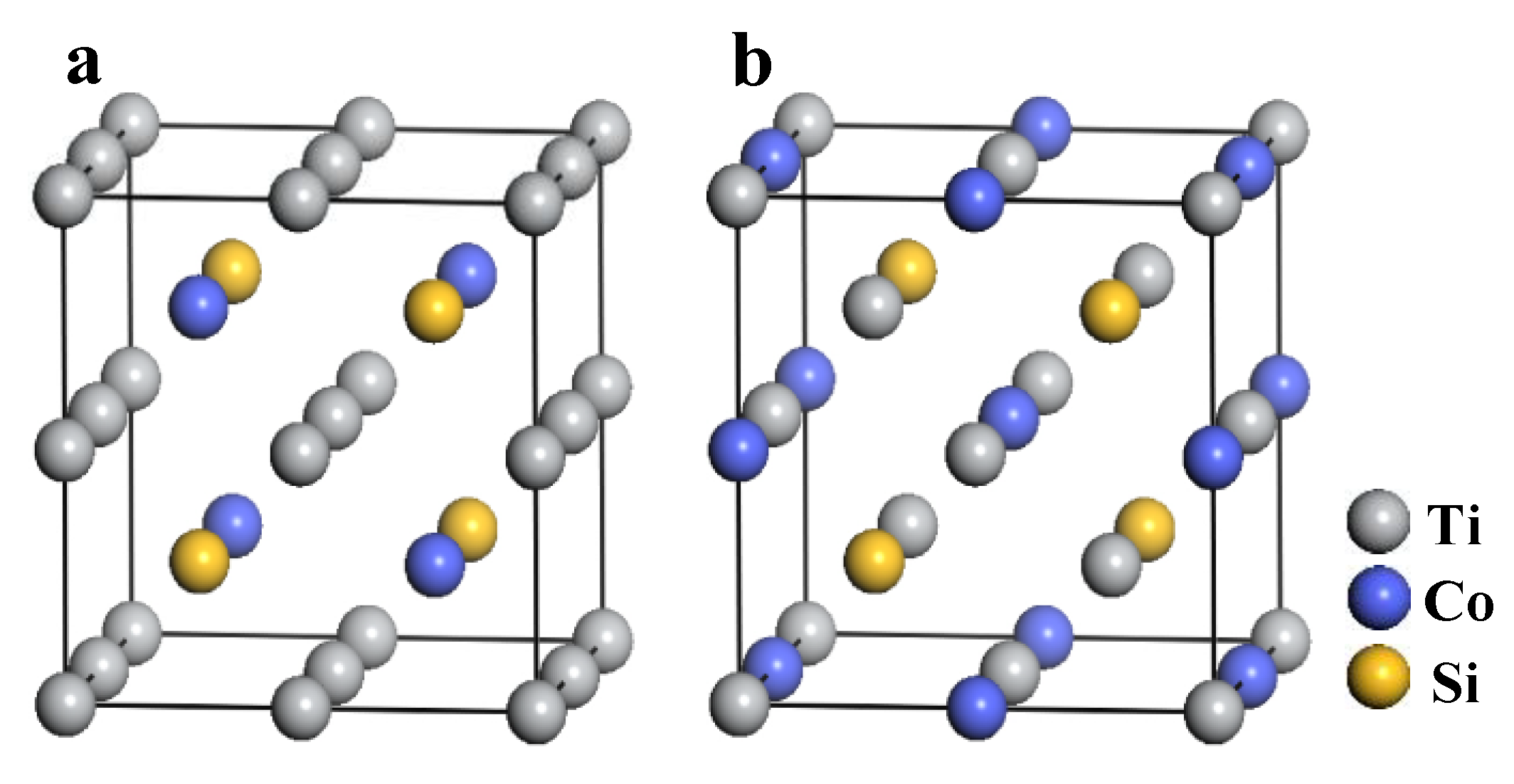
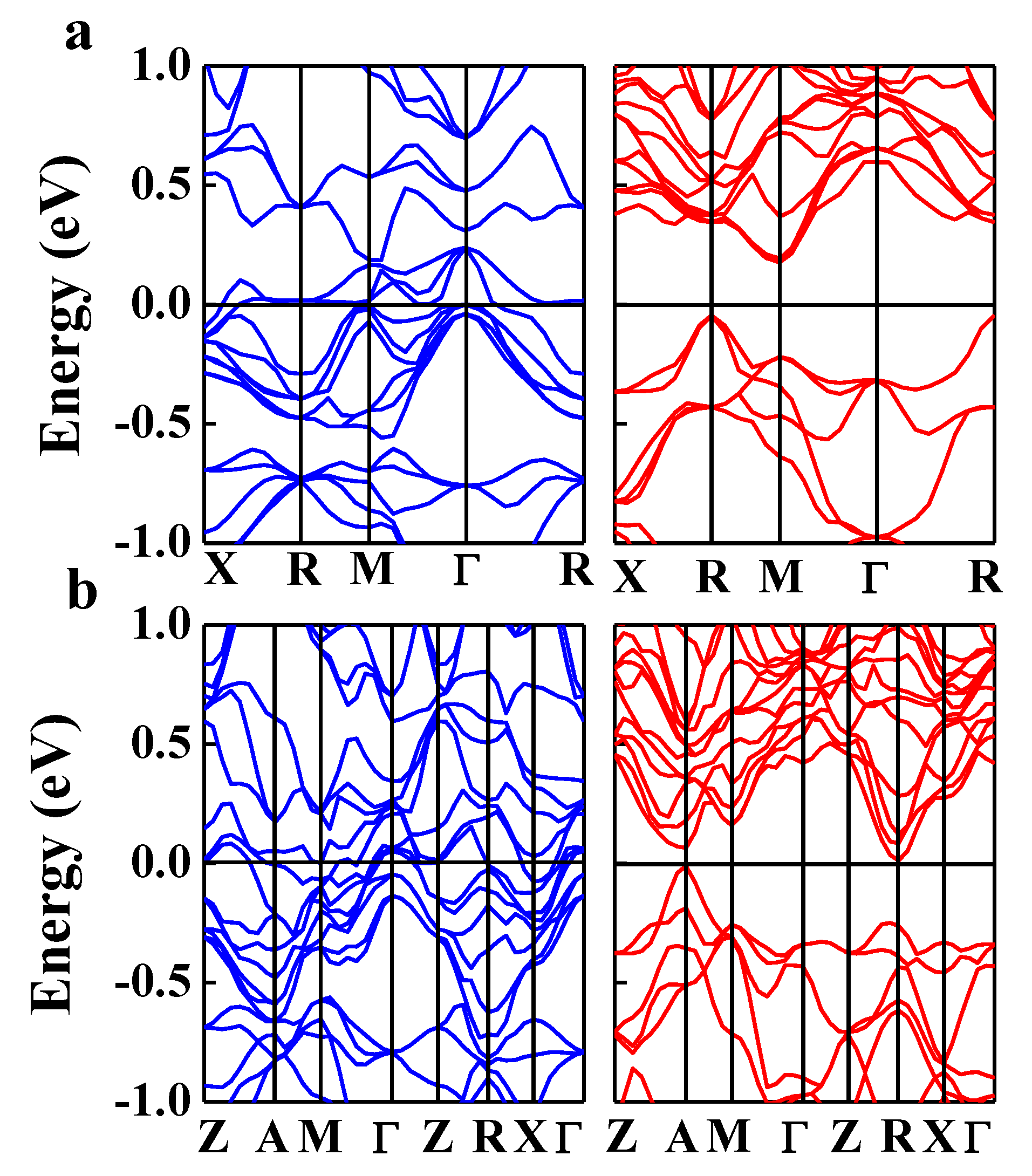
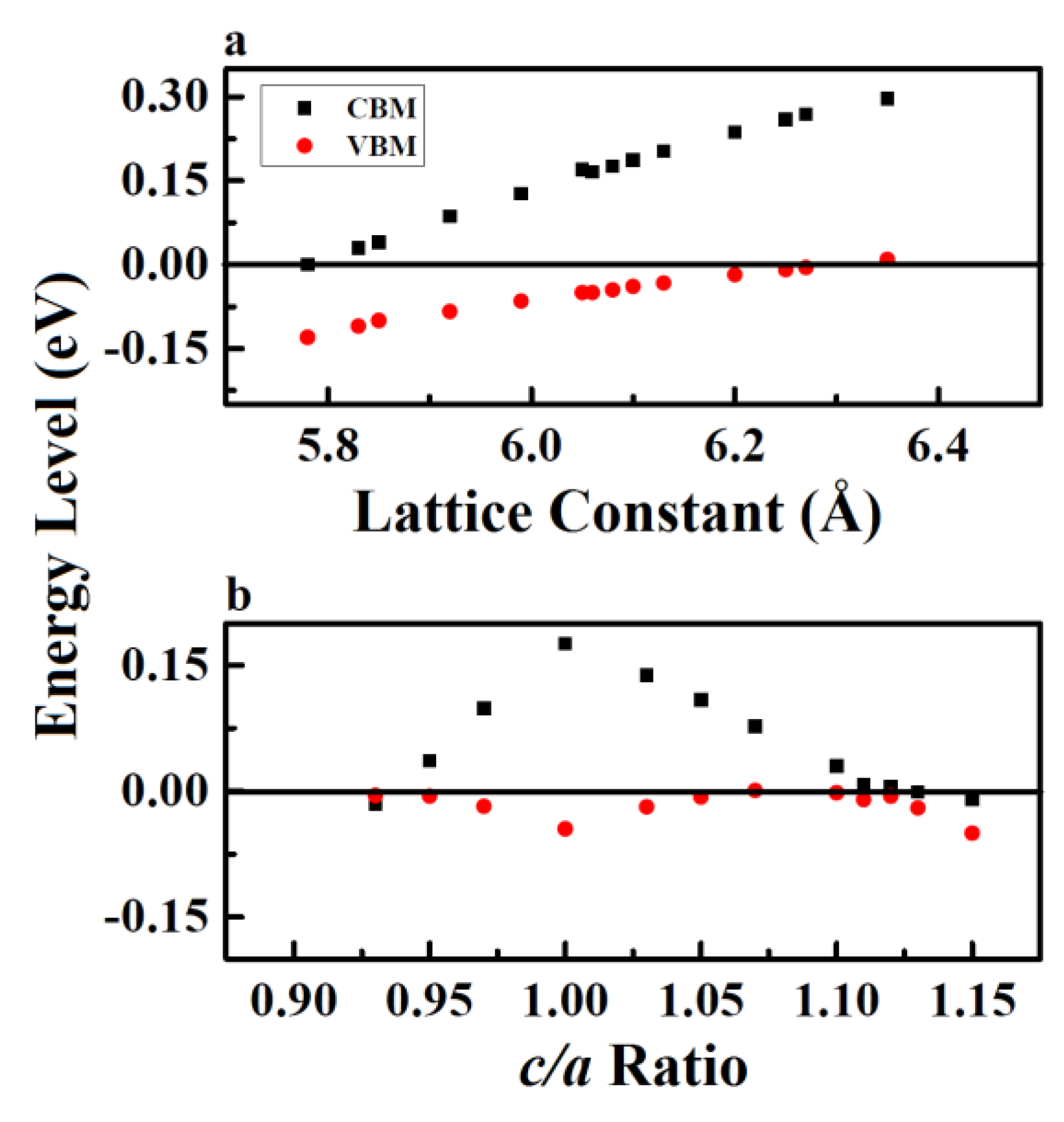
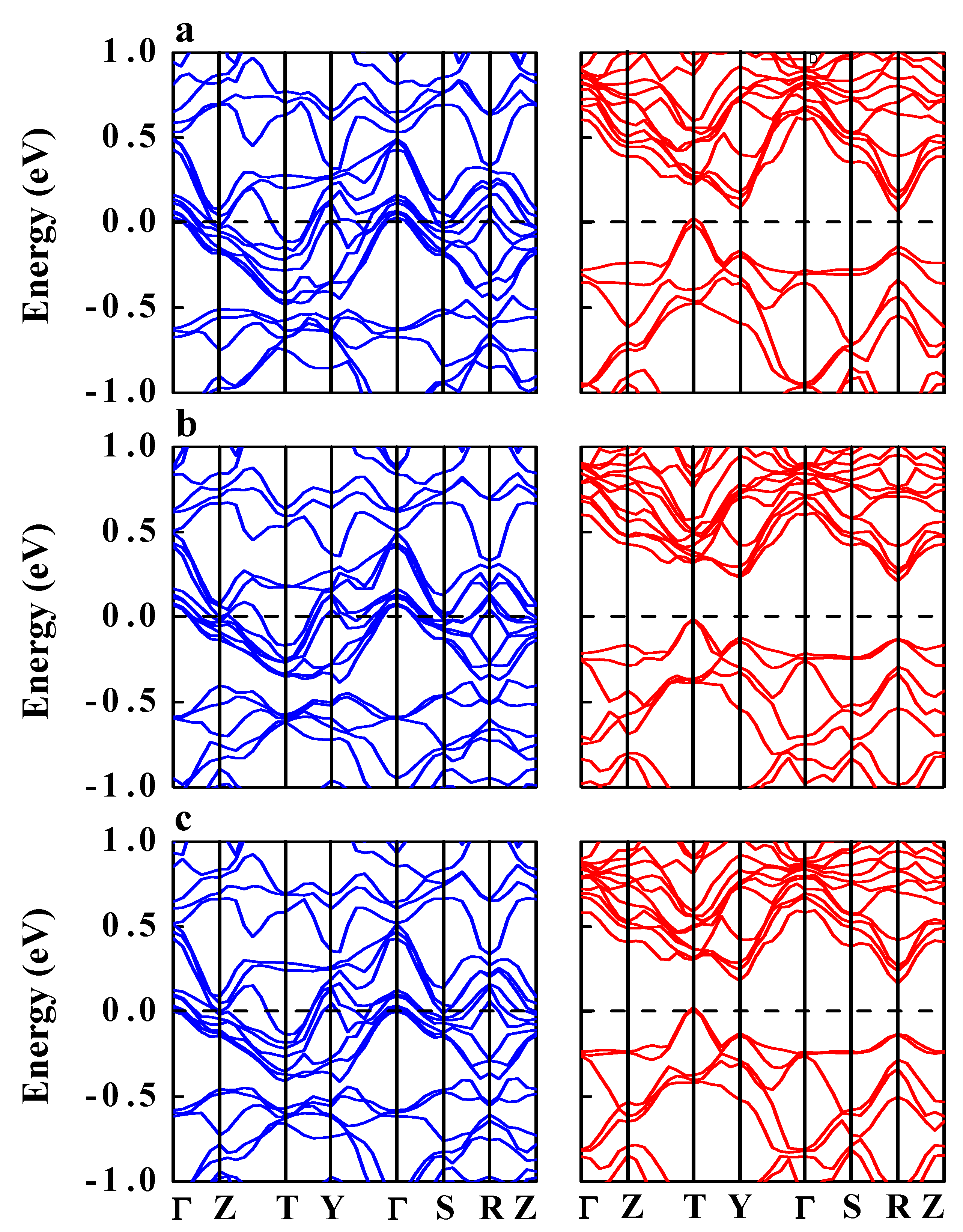
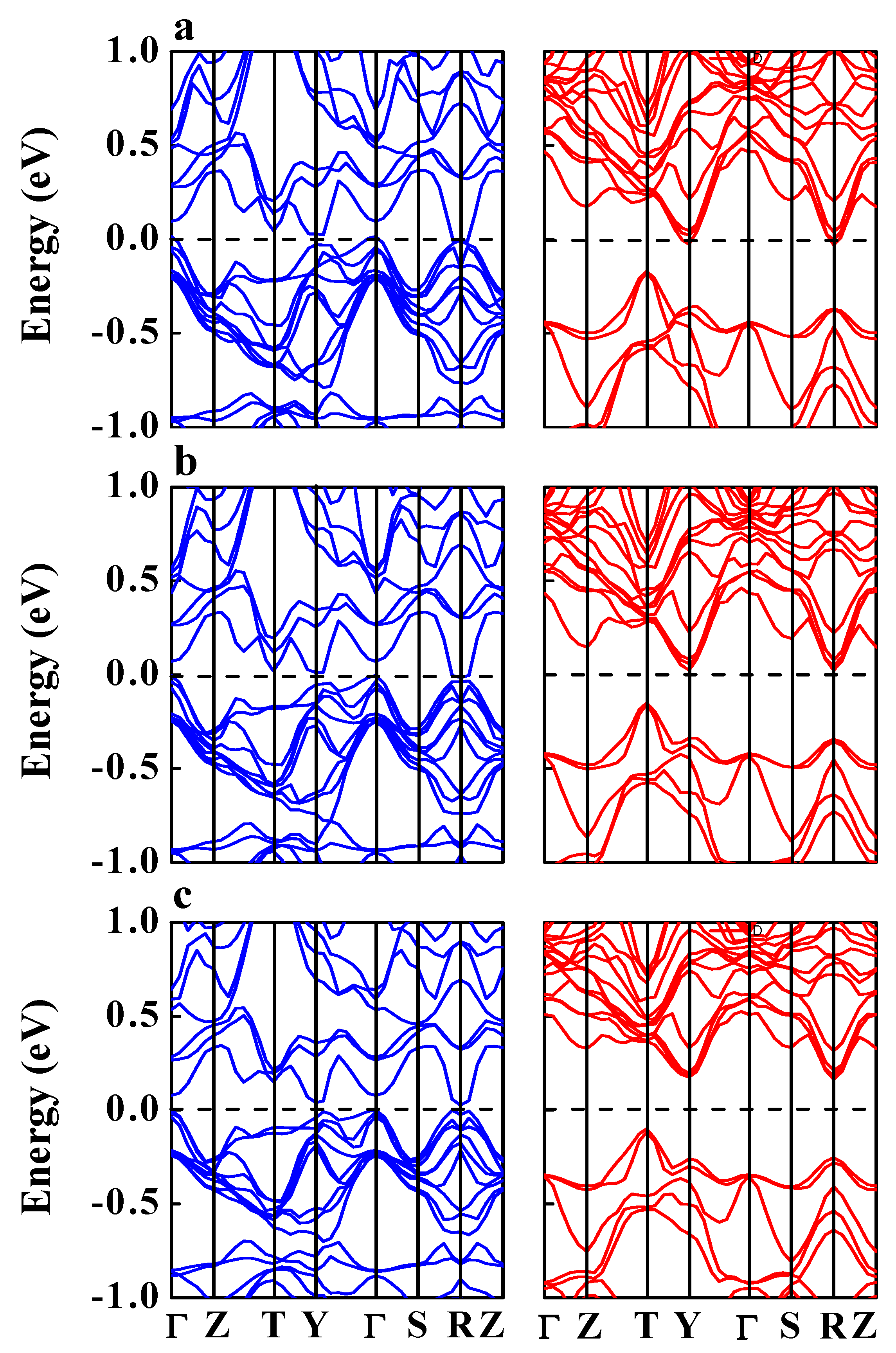
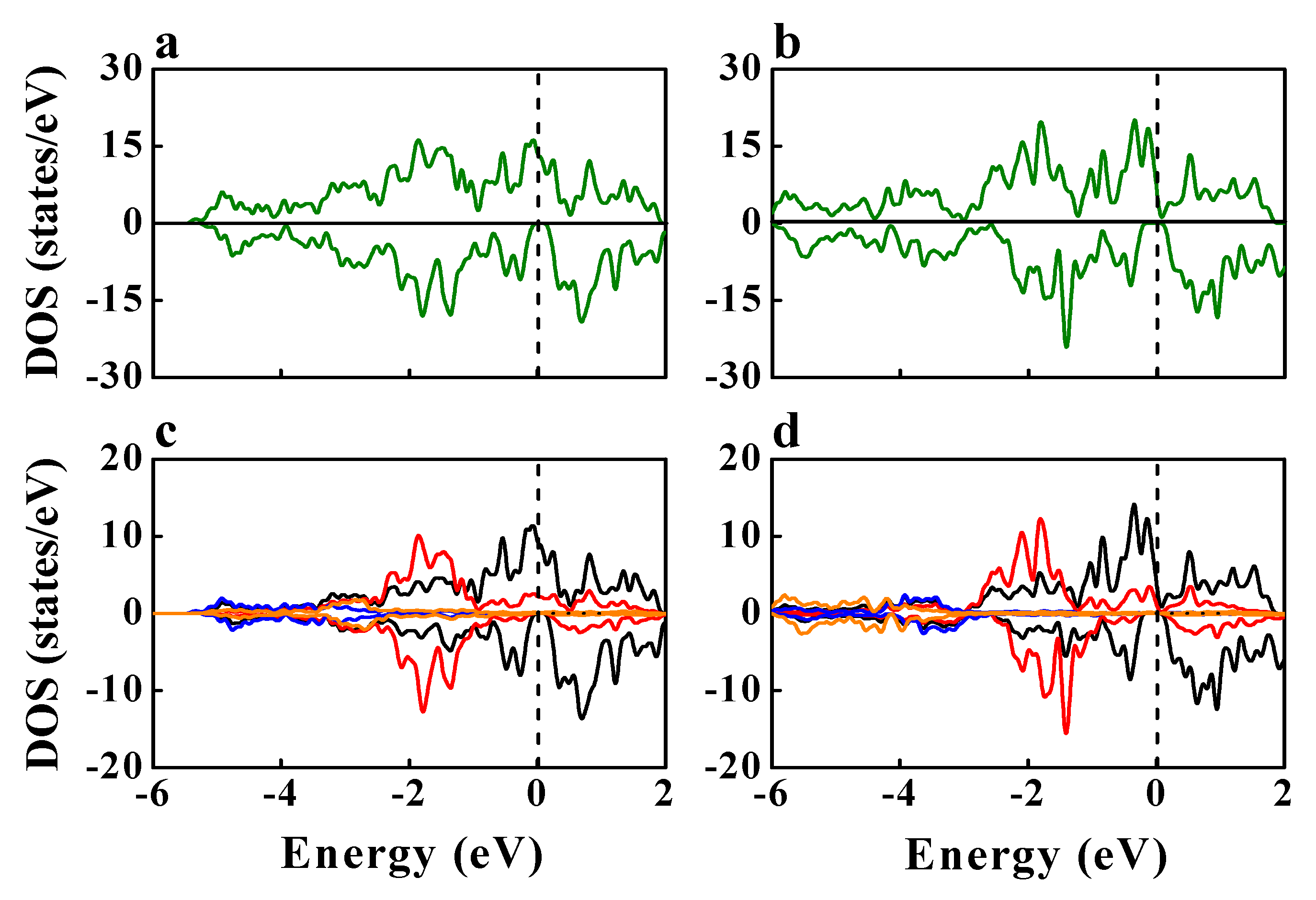
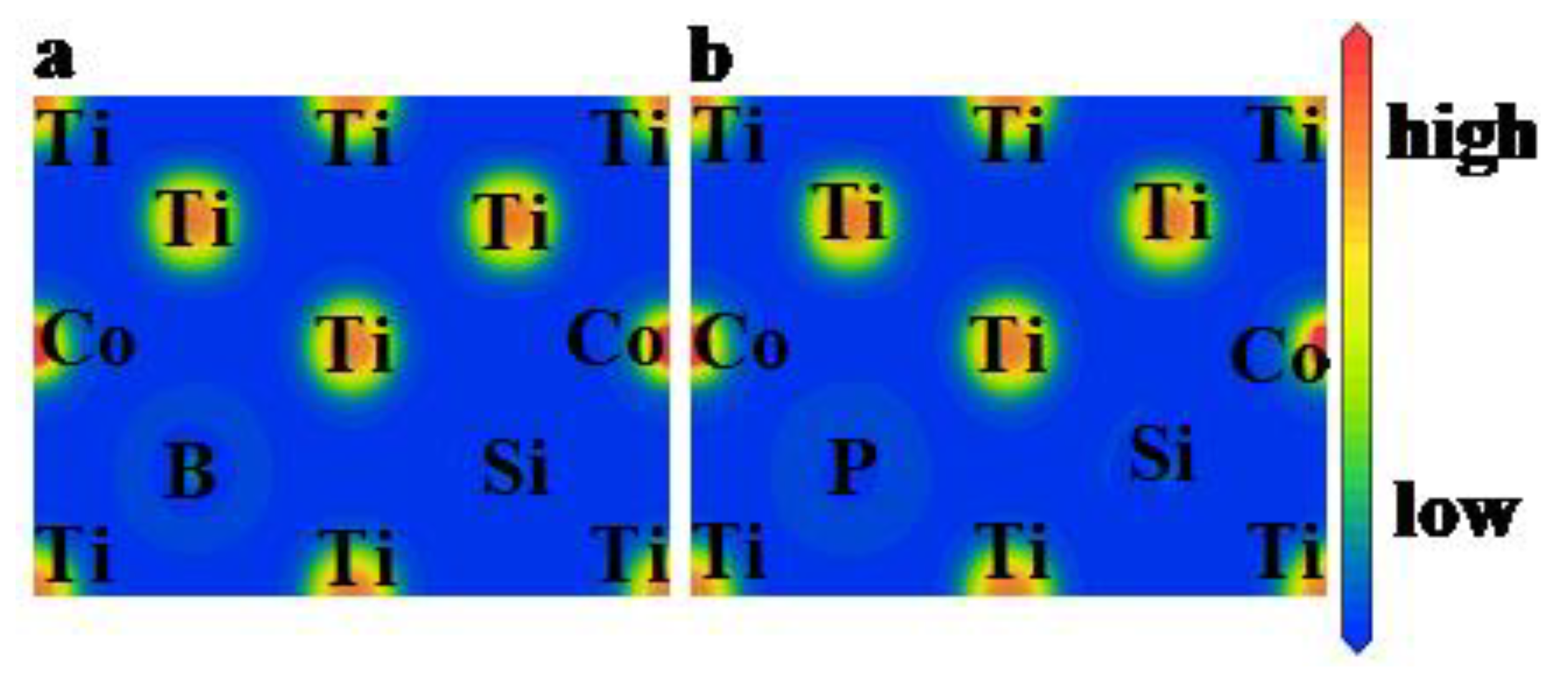
| Compound | ao | Δ E | μtot |
|---|---|---|---|
| Ti2.25Co0.75Si | 6.08 | 1.171 | 7.00 |
| Ti2.25Co0.75Si0.5B0.5 | 6.01 | 0.607 | 5.00 |
| Ti2.25Co0.75Si0.5Al0.5 | 6.13 | 0.592 | 5.00 |
| Ti2.25Co0.75Si0.5Ga0.5 | 6.13 | 0.673 | 5.00 |
| Ti2.25Co0.75Si0.5P0.5 | 6.04 | 0.705 | 8.91 |
| Ti2.25Co0.75Si0.5As0.5 | 6.12 | 0.830 | 9.00 |
| Ti2.25Co0.75Si0.5Sb0.5 | 6.25 | 0.963 | 9.00 |
© 2020 by the authors. Licensee MDPI, Basel, Switzerland. This article is an open access article distributed under the terms and conditions of the Creative Commons Attribution (CC BY) license (http://creativecommons.org/licenses/by/4.0/).
Share and Cite
Zhang, L.; Dong, S.; Du, J.; Lu, Y.-L.; Zhao, H.; Feng, L. First-Principles Forecast of Gapless Half-Metallic and Spin-Gapless Semiconducting Materials: Case Study of Inverse Ti2CoSi-Based Compounds. Appl. Sci. 2020, 10, 782. https://doi.org/10.3390/app10030782
Zhang L, Dong S, Du J, Lu Y-L, Zhao H, Feng L. First-Principles Forecast of Gapless Half-Metallic and Spin-Gapless Semiconducting Materials: Case Study of Inverse Ti2CoSi-Based Compounds. Applied Sciences. 2020; 10(3):782. https://doi.org/10.3390/app10030782
Chicago/Turabian StyleZhang, Liang, Shengjie Dong, Jiangtao Du, Yi-Lin Lu, Hui Zhao, and Liefeng Feng. 2020. "First-Principles Forecast of Gapless Half-Metallic and Spin-Gapless Semiconducting Materials: Case Study of Inverse Ti2CoSi-Based Compounds" Applied Sciences 10, no. 3: 782. https://doi.org/10.3390/app10030782
APA StyleZhang, L., Dong, S., Du, J., Lu, Y.-L., Zhao, H., & Feng, L. (2020). First-Principles Forecast of Gapless Half-Metallic and Spin-Gapless Semiconducting Materials: Case Study of Inverse Ti2CoSi-Based Compounds. Applied Sciences, 10(3), 782. https://doi.org/10.3390/app10030782





